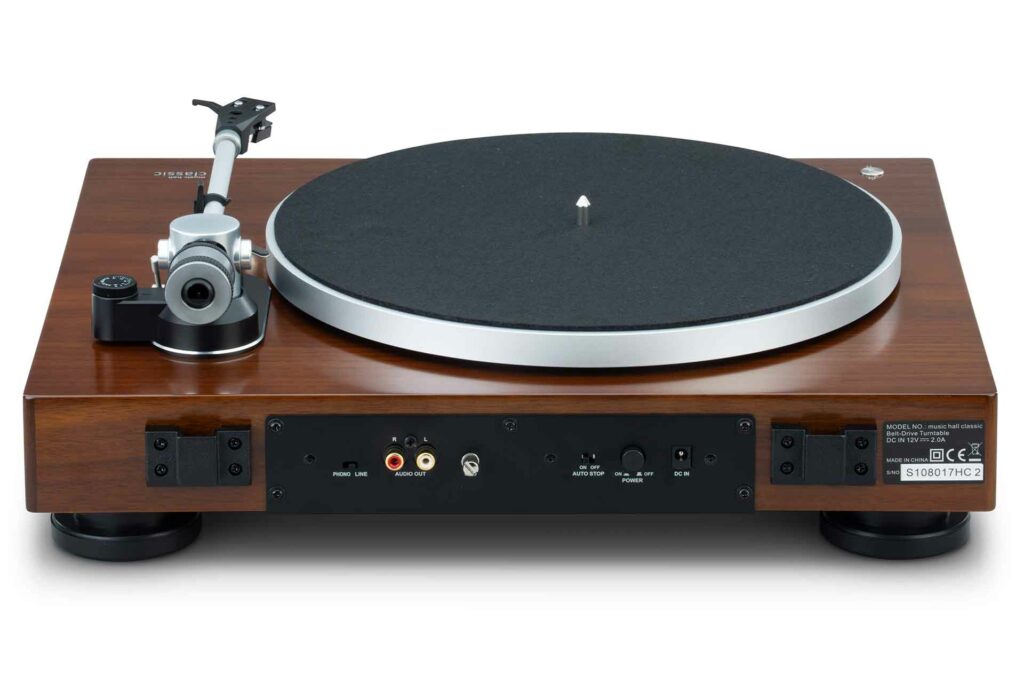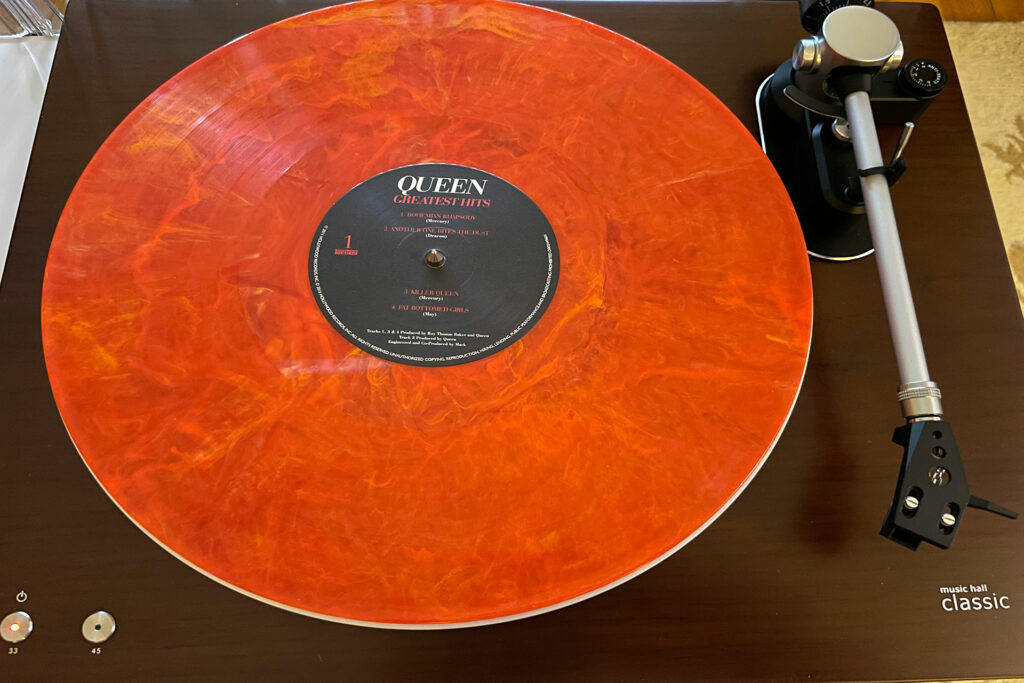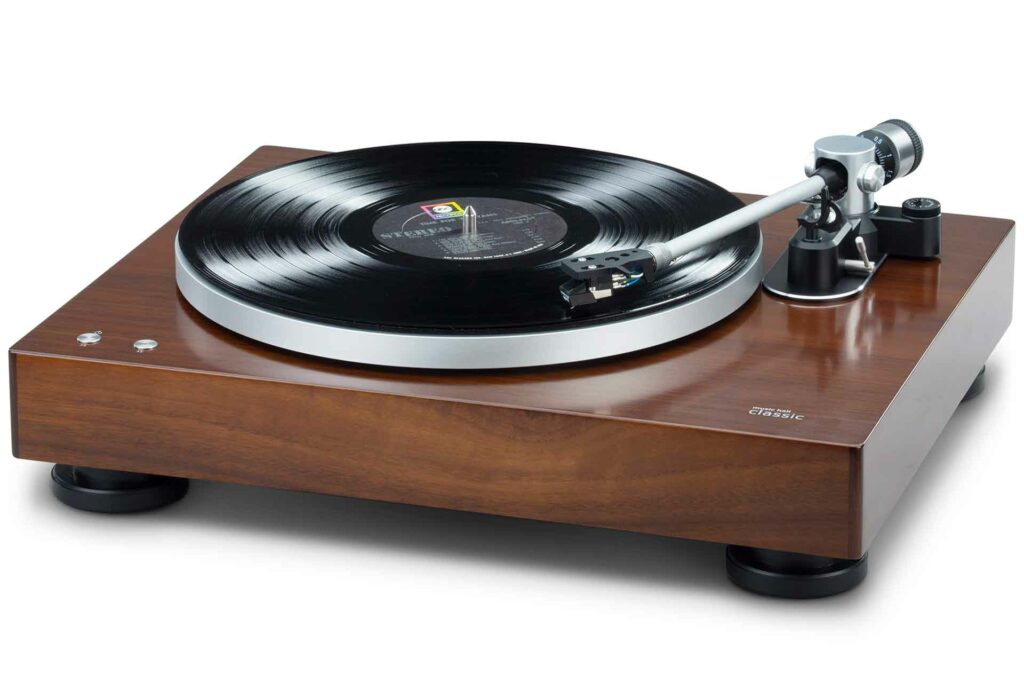The Music Hall Classic turntable (buy at Crutchfield) features an intriguing mix of traditional design elements and modern technology and features. The turntable comes packaged with a tonearm and cartridge, which are partially assembled so the listener can go from unboxing to listening to vinyl in short order. The built-in phono preamp (in the actual turntable) provides additional flexibility and ease of integration for those whose systems do not already include a phono stage. Not every stereo preamp has a suitable or capable phono stage, so you’re getting pretty much everything you need for an audiophile vinyl experience without the bulk, cost, or complication of a second box that may or may not be a good fit for your turntable’s cartridge.

What Makes the Music Hall Classic Turntable Special?
- Setup is easier than it is with most turntable, and there’s a good bit less guesswork to boot. Providing a complete package bypasses the sometimes overwhelming need to select a tonearm and cartridge combination that will work well with your turntable. This is a common question from new turntable owners. The included Music Hall MM Spirit cartridge normally sells for $100 if purchased separately. The cartridge has an output voltage of 3.5mV and recommended load impedance of 47k Ohms.
- The included unipivot tonearm appears to be made from aluminum and is slightly under nine inches in length. The adjustable and clearly marked counterweight system made adjusting the tracking force simple. I preferred the adjacent anti-skating control knob to the effective, but sometimes tricky, weight on a string system.
- The Music Hall Classic turntable comes with a built-in, but defeatable, phono stage so you are not out of luck if your preamplifier only has line-level inputs.
- The Classic has the appearance of a vintage turntable from the last millennium, including the thick, walnut veneer covered MDF base and clear acrylic dustcover. Upon a closer look you will also notice modern, touch sensitive speed controls to select either 33 or 45 revolutions per minute. The controls are linked to an electronic speed control system, which provides consistent and precise rotation speed.
- The Auto Stop function works differently than many traditional setups that use additional mechanical elements during playback, which can impede performance. The Auto Stop function in the Classic senses the lack of signal at the end of the last track. Purists who wish to turn off this feature can do so with a flip of a switch on the back panel.
- Adjustable, vibration-dampening feet also have a simple, retro aesthetic but allow for easy leveling of the thick platform and are effective in reducing vibrations.
- The Music Hall Classic weighs in at 15.2 pounds and measures 17-1/8 inches wide, by 6-1/4 inches high and 14-1/2 inches deep, this is slightly bigger than some of the other turntables I have recently reviewed, with the most noticeable difference being the extra height. Music Hall specifies the wow and flutter at less than .12 percent typical with a limit of less than .15 percent and speed tolerance of +/- 3 percent. The signal to noise ratio is a stated as 62dB.
- Unboxing and assembling the Music Hall Classic Turntable took about fifteen minutes. My 15-year-old son, who did the unboxing and assembly, felt the instructions were not particularly clear, but I did not have any problems following them.
- Many enthusiasts like the auto-lift feature on the tone arm which can protect your record collection from any shaky hands resulting in unwanted scratches.
Why Should You Care About the Music Hall Classic Turntable?
Music Hall’s Classic audiophile turntable provides an easy to use, all-in-one solution for any music lover who is looking to add a turntable to their system. The combination of components provides good performance at a competitive price. One would be hard pressed to assemble components that provide the same functionality and level of performance at a similar price.

Some Things You Might Not Like About the Music Hall Classic Turntable
- The turntable has a distinctly retro aesthetic, what with its thick, warm wood base, which may not be the right fit for a system on display in a space with a more modern design aesthetic. This audiophile turntable is more for somebody looking for a less expensive Linn LP-12 than someone looking for an Oracle turntable.
- The Music Hall Classic does not have the same variety of upgrade options as some of the other turntables in this category and price range. Perusing the Music Hall website, the company offers cork mats and an acrylic platter as upgrades. While a cork mat should work fine, the Music Hill Classic turntable is not one of the models listed as compatible with the acrylic platter. So, if you are one to tinker and upgrade, you will need to explore third-party sources to do so.
Listening to the Music Hall Classic Turntable…
While my 15-year-old son did the actual setup work, I was standing next to him and observing at all times. The process was straightforward, but he found the instructions to be a bit harder to follow than some of the other turntables we have been setting up recently. Nonetheless, assembly and adjustments took only about 15 minutes. The tracking force and anti-skate adjustments were easy to make with their clearly labelled controls. We started our listening by bypassing the Music Hall Classic’s built-in phono stage in favor of those in the Marantz Model 30 (buy at Crutchfield) and Margules Audio Arch-3 integrated amplifiers.
We started with the same albums we have been using in our other recent turntable reviews. “Eleanor Rigby” from The Beatles:1 album sounded very similar to the way it did through the Pro-Ject Debut Carbon EVO (buy at Crutchfield), with prominent vocals that were clear and neutral. The soundstage was large, extending slightly beyond the outer edges of my speakers. As with the Pro-Ject, I was able to easily discern the detail and layering the violas, violins, and cellos but I felt the Project had a smidge more low-level detail. Listening to the acoustic guitar from “Yesterday” produced a big, full image that sounded natural and relaxed. The bass was solid and provided a good foundation for a presentation that had a slightly forward midrange.
I was not surprised to find the bass from the drums on “We Will Rock You” from Queen’s Greatest Hits to be bigger and fuller than on the Audio Technica table and very similar but perhaps even a touch fuller than on the Carbon EVO table. Likewise, the midrange was prominent and detailed, with just a touch more noise than the Carbon EVO.
I added a third track this time, with an album fellow reviewer Sean Killebrew gave me as a birthday gift: the Red Hot Chili Peppers’ Stadium Arcadium. Listening to “Dani California,” John Frusciante’s guitar work was conveyed with emotion, which engaged me enough to listen to the rest of that side even though I knew I had to move on and do other things. I then got up and tried comparing the Classic’s internal phono stage with those in the Marantz and Margules integrated amplifiers. The Classic’s phono stage was better than I would have anticipated but both Marantz and Margules were able to provide better dynamics and more detail. The Classic’s phono stage did nothing wrong and is likely better than that of many receivers, but it leaves some of the performance on the table (pun intended).
Does the Music Hall Classic Turntable Have Any Resale Value?
Yes. Analog sources tend not to get outdated as quickly as digital ones do. There are not new codecs and transmission standards being introduced. Longevity comes down to build quality and serviceability. The main wear item on any belt-driven turntable is the belt, which is easily and inexpensively replaced when needed. Music Hall has a great reputation for service over year and years.

Who Is the Competition for the Music Hall Classic?
Vinyl lovers are benefitting from the resurgence of the format, with a wide selection of turntables in the $500-to-$650 range. In addition to the Music Hall Classic turntable, we are in the process of reviewing the Audio-Technica AT-LPW50BT ($499 buy at Crutchfield), Pro-Ject’s Debut Carbon EVO ($599 buy at Crutchfield), and the Rekkord F300 ($549). All of these models come with tonearms and cartridges.
The Audio-Technica also comes with a built-in phono stage and is a fully manual, belt-driven turntable. It is unique in this group as it also features a built-in Bluetooth transmitter.
The Pro-Ject Debut Carbon EVO is a fully manual, belt-driven turntable that is available in a variety of colors. Performance wise, it has a similar sound to the Classic.
The Rekkord is belt driven and sets itself apart as being the only fully automatic in this group. Lastly, while not currently in line for review, we would be remiss not to mention Rega’s Planar 1 ($595 buy at Amazon), the company’s entry-level direct-drive turntable. It can be had with or without a built-in phono stage and there are plenty of factory upgrade paths for the P series.

Final Thoughts on the Music Hall Classic Turntable
Music Hall’s Classic lives up to the company’s well-earned reputation of providing high-performance turntables for not a lot of money. With the Classic, Music Hall takes the guesswork out of gathering and assembling the components necessary for a good-sounding rig. Just a few minutes from opening the box, you can be enjoying the warm, slightly forward but well-formed midrange that is captivating. While I generally prefer a more modern aesthetic, I found the retro vibe of the Classic to be appropriate when spinning vinyl, and as I always place my turntables on the top shelf, the extra height was not a problem. With the Music Hall Classic, I found myself forgetting about reviews and simply listening to music.



